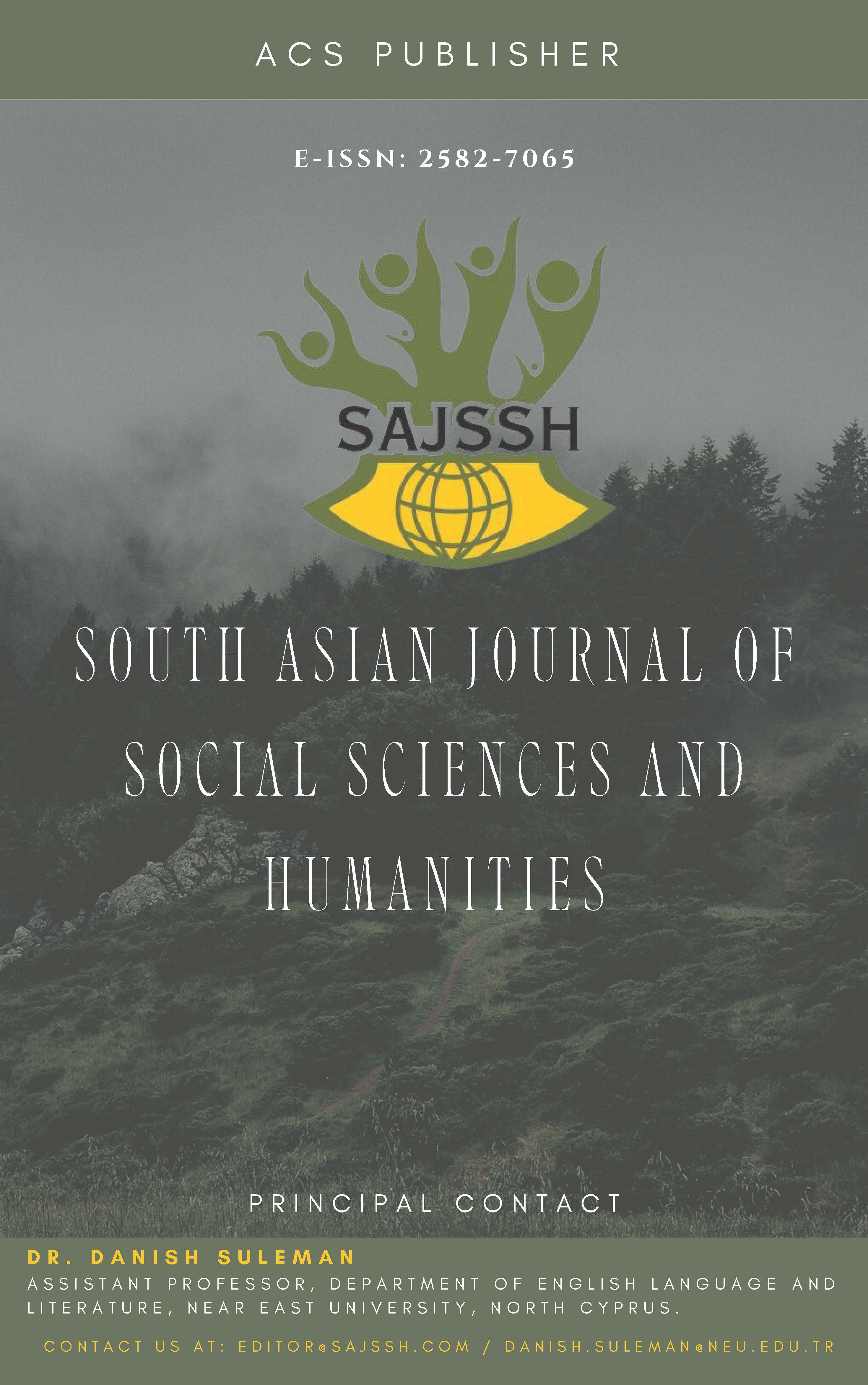Puberty Period among Different Religions, Traditions, and Societies
DOI:
https://doi.org/10.48165/sajssh.2022.3411Keywords:
Puberty, Traditions, rituals, Menstrual period, femaleAbstract
Abstract: Puberty is an important stage of human life. Several physiological alterations accompanying the teenage years manifest themselves in often complex and curious means to which females show different reactions. Even though this stage of a female's life is normal, it is often associated with some degree of suffering and embarrassment, it is mainly due to a sense of hesitation. The main event of puberty is the onset of the menstrual cycle; menstruation is a normal physiological process that has been distorted and damaged with negative connotations. Many religions around the world have set expectations for females during their menstrual period. This paper discusses how females during puberty must behave and be seen in many religions. Additionally, it drives debates on how different societies treat and view females during the menstrual period. Adolescent girls must be educated on how to go about the topics surrounding puberty, and the normal physiological changes that happen during the period at school. Societies, families, and teenagers themselves are responsible for working together to create an environment in which accurate info on puberty and related subjects is readily available.
References
WHO. Adolescent health. [Internet]. 2013 [cited 2021 May 31]. Available from: www.who.int/topics/adolescent_health/en.
Brêtas JRS, Tadini AC, Freitas MJD, Goellner MB. Meaning of menarche according to adolescents. ACTA Paul Enferm 2012;25(2):249–55. URL: http://dx.doi.org/10.1590/S0103-21002012000200015.
Abdulrasol ZA, Ibrahimi SJ. Assessment of primary dysmenorrhea and its effect on the quality of life among female students at University of Babylon. Indian Journal of Forensic Medicine and Toxicology. 2020;14(3):1632–8. URL: https://medicopublication.com/index.php/ijfmt/article/view/.
Kouhestani HR, Rouzbahani N, Baghcheghi N. Adolescent boys’ lived experience of puberty: A qualitative study. Iran Journal of Nursing 2009; 22(57):67–76. URL: http://ijn.iums.ac.ir/browse.php?a_id=609&sid=1&slc_lang=en.
Ozdemir F, Nazik E, Pasinlioglu T. Determination of the motherly reactions
to adolescents' experience of menarche. J Pediatr Adolesc Gynecol 2010;
(3):153–157. URL: https://doi.org/10.1016/j.jpag.2009.09.001.
Reardon LE, Leen-Feldner EW, Hayward C. A critical review of the empirical literature on the relation between anxiety and puberty. Clin Psychol Rev
; 29(1):1–23. URL: https://dx.doi.org/10.1016%2Fj.cpr.2008.09.005.
Ahmadi F, Anoosheh M, Vaismoradi M, Safdari M. The experience of puberty in adolescent boys: an Iranian perspective. Int Nurs Rev 2009; 56(2):257–263. URL: https://doi.org/10.1111/j.1466-7657.2008.00670.x.
Narayan KA, Srinivasa DK, Pelto PJ, Veerammal S. Puberty Rituals, Reproductive Knowledge and Health of Adolescent Schoolgirls in South India. Asia Pac Popul J 2001;18:225-38. URL: http://www.unescap.org/ESID/psis/population/journal/Articles/2001/V16N2A14.pdf.
Verma DP, Pandya DC, Ramanuj DV, Singh DM. Menstrual Pattern of Adolescent School Girls of Bhavnagar (Gujarat): Menstrual Pattern Of Adolescent School Girls. Natl J Integr Res Med 2011;2(1):39-1. URL: http://nicpd.ac.in/ojs-/index.php/njirm/article/view/1895.
Khanna A, Goyal RS, Bhawsar R. Menstrual practices and reproductive problems: A study of adolescent girls in Rajasthan. Journal of Health Management 2005; 7(1):91-97. URL: https://doi.org/10.1177%2F097206340400700103.
Mudey AB, Keshwani N, Mudey GA, Goyal RC. A cross-sectional study on the awareness regarding safe and hygienic practices amongst school going adolescent girls in the rural areas of Wardha district. Global Journal of Health Science 2010; 2(2):225-231. URL: https://doi.org/10.5539/gjhs.v2n2p225.
El-Gilanya A, Badawi K, EL-Fedawyb S. Menstrual hygiene among adolescent school girls in Mansoura, Egypt. Reproductive Health Matters 2005; 13:147–152. URL: https://doi.org/10.1016/S0968-8080(05)26191-8.
Thakre SB, Thakre SS, Reddy M, Rathi N, Pathak K, Ughade S. Menstrual hygiene: knowledge and practice among adolescent school girls of Saoner, Nagpur district. J Clin Diagn Res 2011;5(5):1027-1033. URL: https://www.researchgate.net/profile/Suresh_Ughade/publication/267415792_Menstrual_Hygiene_Knowledge_and_Practice_among_Adolescent_School_Girls_of_Saoner_Nagpur_District/links/54c7c3620cf289f0cecdc3eb.pdf.
Golchin NA, Hamzehgardeshi Z, Fakhri M, Hamzehgardeshi L. The experience of puberty in Iranian adolescent girls: a qualitative content analysis. BMC public health 2012;12(1):1-8. URL: https://doi.org/10.1186/1471-2458-12-698.
Zare M, MalekA Afzali H, Jandghi J, Alammeh M, Kolahdoz M, Asadi O.
Effect of training regarding puberty on knowledge, attitude and practice
of 12–14 year old girls. Journal of Guilan University of Medical Sciences 2006, 14(56):18–26. URL: http://journal.gums.ac.ir/article-1-491-en.html.
Petree, Karen. “Tabooing the Taboo: Toward an Ethnography of Menstruating Third Wave Feminists.” 2010. URL: http://cdn.nycitynewsservice.com/blogs.dir/549/files/2013/04/Tabooing-the-Taboo.pdf.
Umeora OU, Egwuatu VE. Menstruation in rural Igbo women of south east Nigeria: attitudes, beliefs and practices. African Journal of Reproductive Health 2008;12(1):109-15. URL: http://dx.doi.org/10.2307/25470641.
Long JL, Caruso BA, MAMANI M, Camacho G, Vancraeynest K, Freeman MC. Developing games as a qualitative method for researching menstrual hygiene management in rural Bolivia. Waterlines 2015; 34(1):68-78. DOI:10.3362/1756-3488.2015.007.
Bhartiya A. Menstruation, religion and society. International Journal of Social Science and Humanity 2013;3(6):523. DOI: 10.7763/IJSSH.2013.V3.296.
Guterman M, Mehta P, Gibbs M. Menstrual taboos among major religions. The Internet Journal of World Health and Societal Politics 2008;5(2):2. DOI: 10.5580/1443.
Hartman T, Marmon N. Lived regulations, systemic attributions: Menstrual separation and ritual immersion in the experience of Orthodox Jewish women. Gender & Society 2004;18(3):389-408. URL: http://www.jstor.org/stable/4149408.
Guterman M. "Observance of the Laws of Family Purity in Modern-Orthodox Judaism." Archives of Sexual Behavior 2008; 37 (2): 340-345. DOI: 10.1007/s10508-007-9261-5.
Secunda S. The Talmud's Red Fence: Menstrual Impurity and Difference in Babylonian Judaism and Its Sasanian Context. Oxford University Press, USA; 2020 Jun 9. URL: https://oxford.universitypressscholarship.com/view/10.1093/oso/9780198856825.001.0001/oso-9780198856825
Downloads
Published
Issue
Section
License
Copyright (c) 2022 South Asian Journal of Social Science and Humanities

This work is licensed under a Creative Commons Attribution 4.0 International License.





